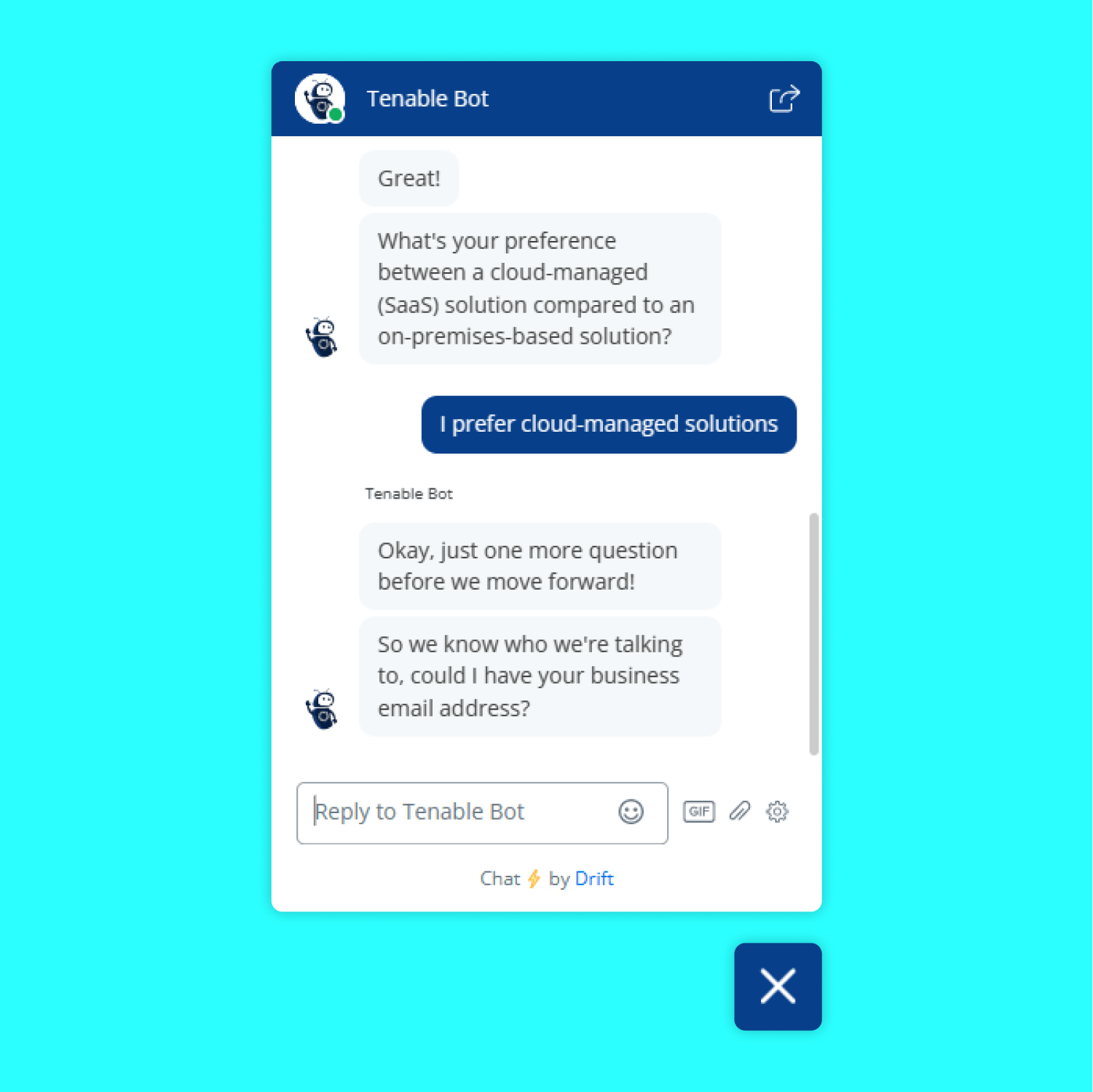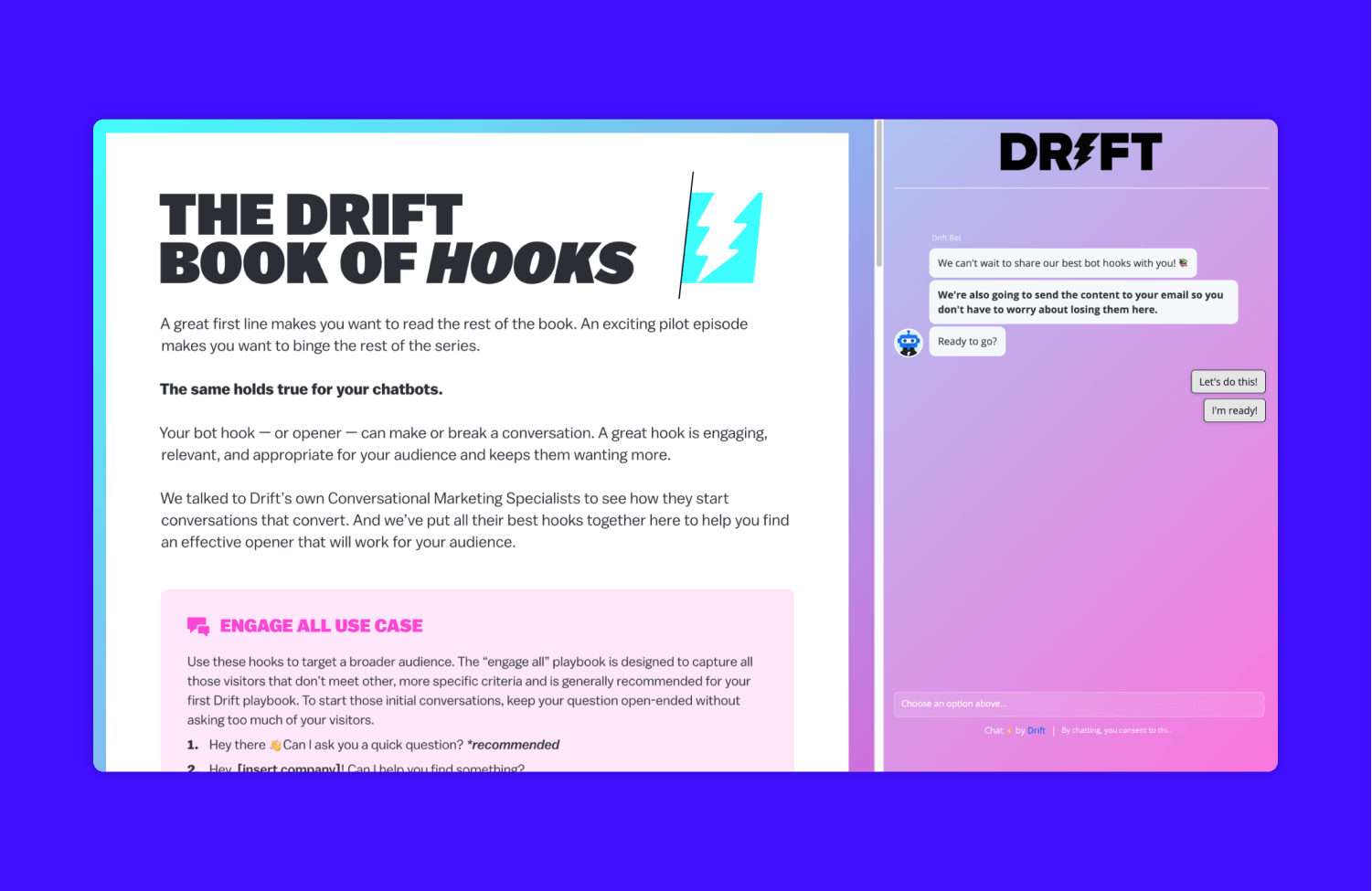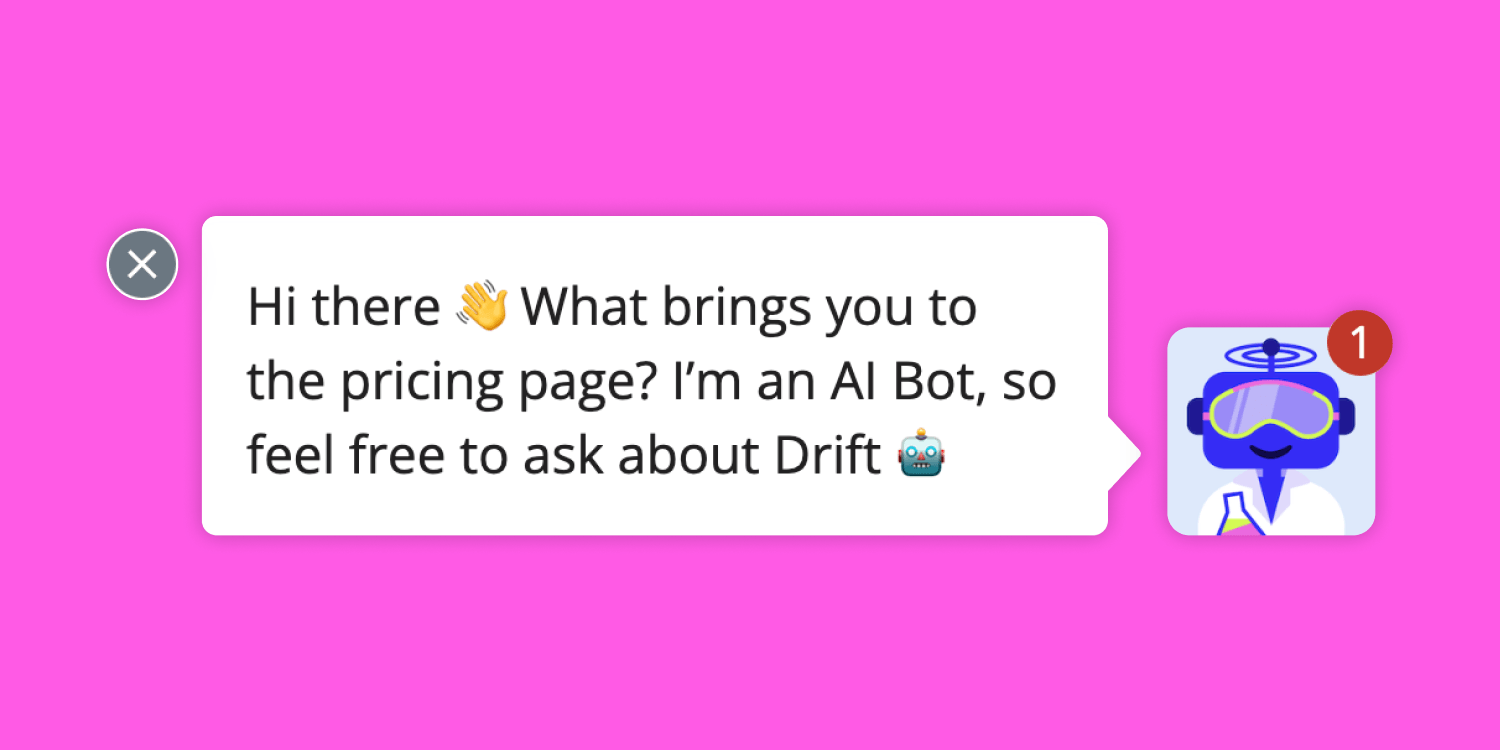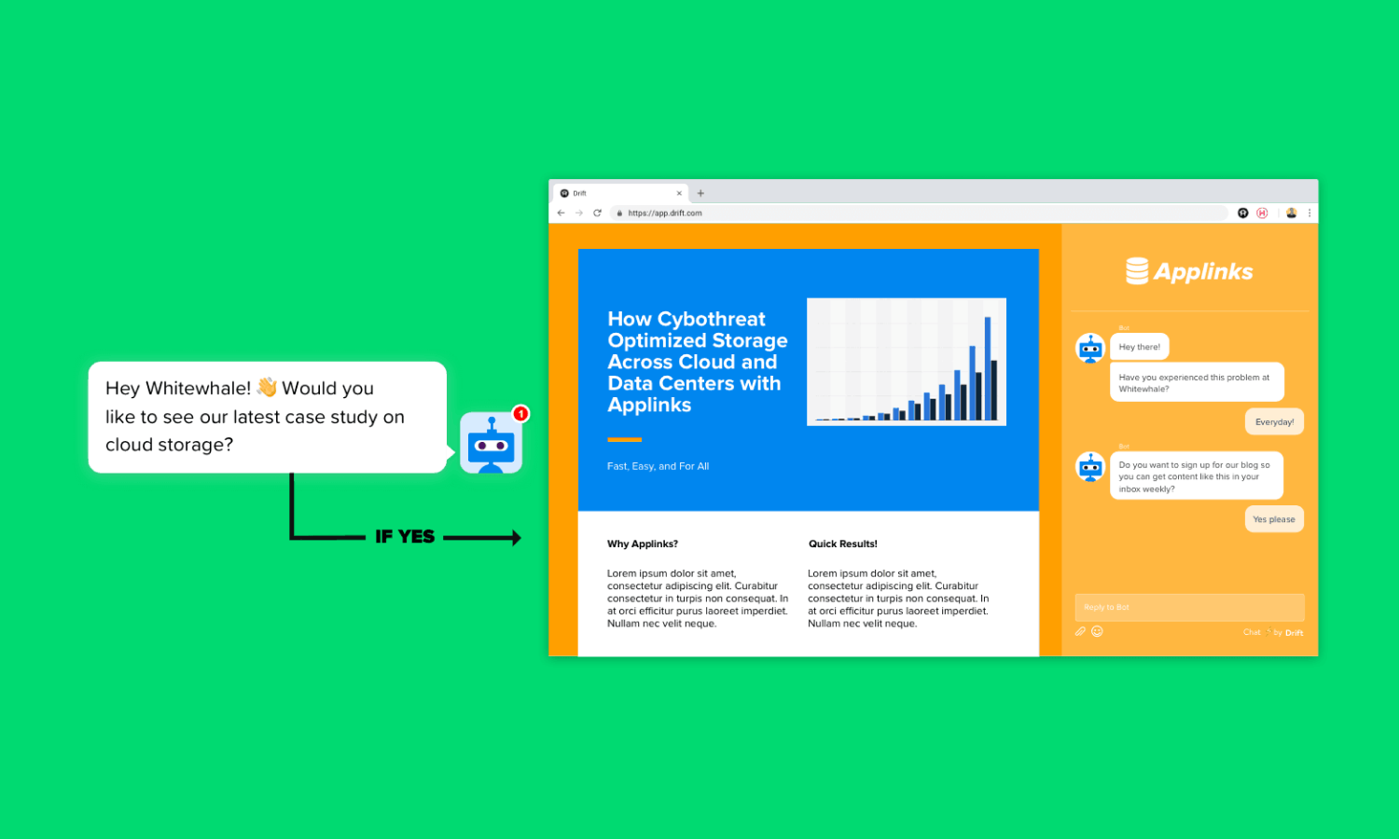No one uses chatbots the way that marketers do.
Because we don’t just put chatbots on our websites to answer questions and deal with weekend site traffic. We use them to craft segmented, personalized buying experiences that are fun, fast, and on brand.
But all of that segmentation and personalization means that chatbot marketing can get really complicated. After all, a team of conversational marketers might have hundreds of sequences (or playbooks) running at the same time.
So how do you build a chatbot marketing strategy that drives qualified leads and revenue?
In this ultimate guide to chatbot marketing, we tackle what exactly chatbot marketing is and all the benefits you can expect to gain from it. Plus, we showcase top-notch examples and best practices to help you make the most of your chatbot software.
Let’s get started 🤖
What Is Chatbot Marketing?
Chatbot marketing is the practice of using automated conversations and AI-generated responses to chat with website visitors at scale. Marketers use chatbots to welcome new site visitors, convert and nurture leads, direct existing customers to customer support, and more.
Today, chatbots are more relevant than ever. Modern buyers are worn out from complex buying processes and long Zoom calls. That’s why 87% of B2B buyers want a fully or partly self-serve buying model. And with the right chatbot experiences, you can successfully create the self-serve experience that your customers crave.
So, while customer support was the first widespread use case for chatbots, it’s no surprise that this technology has now become popular among B2B marketing and sales teams that want to speed up their buying cycle and serve their audience faster than their competition.
Benefits of Chatbots for Marketing Teams
Chatbots supercharge your entire marketing strategy. You can use them to answer questions, share resources, and nudge leads along — all in an instant.
Here are some of the biggest benefits of chatbot marketing 👇
Convert More Website Traffic
No matter what action you’re encouraging site visitors to take, chatbots can help guide more site visitors to a conversion, faster. That’s because chatbots meet visitors where they are, respond to their specific needs and interests in real time, and make it easy for them to take the next step.
Chatbots are great for converting website traffic into free trial users, email subscribers, webinar registrants, asset downloads, and more. Over the course of three years, businesses that use Drift’s chatbots can experience a 100% uplift in their conversation lead to pipeline conversion rate.
Speed Up Response Times
With self-serve buying experiences on the rise, sales cycles are getting longer and longer. Now, the average number of interactions required to close a deal has jumped to 27 — up from 17 in 2019.
In order to speed up the sales cycle, marketers need to facilitate fast and easy interactions that provide potential customers with what they want, when they want.
With chatbots, you can cut your response times from days to seconds without having to boost your headcount. And because chatbots are always-on, you will never have to leave your site visitors hanging — even outside of work hours — which gives leads less reason to jump onto your competitors’ websites.
Segment Traffic at Scale
Every site visitor is unique, and each one deserves an experience that fits them.
Chatbots allow you to serve up personalized experiences to all your site visitors, whether they’re visiting your website for the first time or they’ve been a customer for years. For example, you can set up your chatbot so visitors are empowered to raise their own hands and let you know what they need — just like this example from Gong.
Having visitors self-select their experience is one of the easiest ways to deliver personalization at scale. But, if you want to take your personalization even further, you can leverage customer data to identify specific accounts from your site traffic to surface an experience tailored to them — be it addressing a returning visitor by their first name or rolling out the red carpet for a target account.
Generate More Qualified Leads
Even with all the high-quality traffic that lands on your website everyday, not everyone will be ready for a sales conversation immediately.
Through personalized, human-like conversations, chatbots can gradually guide site visitors into becoming leads. Not only are chatbots able to answer questions and educate people on what your business does, but they also help you capture more interest. After all, only 5% of buyers prefer to fill out a form over interacting with a chatbot.
Here, we see Tenable’s chatbot interacting with a new site visitor and asking for their email address. The chatbot captures leads like a traditional intake form but in a conversational way — making sure that the person’s needs and goals fit what Tenable has to offer.

All this means that chatbot marketing is excellent for driving higher volumes of qualified leads from your website. Plus, with a platform like Drift Conversation Cloud, you will also be able to automatically score your leads and prioritize which accounts you go after based on how good of a conversation-qualified lead they are.
Connect Leads with Sales Faster
Without an automated website experience, it can take days after a potential buyer has filled out a form for you to sort through your leads, qualify them, and then hand them over to sales for a one-on-one conversation. Buyers simply aren’t willing to wait that long to get in touch with you.
But with chatbots, you can automatically qualify leads and connect them with your sales team instantly. And if your sales team is unavailable, the chatbot enables the visitor to book a meeting for a later date.
Sellers can also be notified when their target accounts are on your website — so that way, they can take over for the bot and deliver a personalized experience to their accounts in real time.
Chatbot Marketing Examples
There are so many different things you can achieve with chatbots — and sometimes that makes it hard to know where to start.
Here are some of our favorite examples of really good chatbot marketing that you can draw on for inspiration.
Drift’s Conversational Landing Pages
Let’s say you create an awesome piece of content with a dedicated landing page to go along with it. The copy is great, but it’s static — you can’t directly engage with the people consuming your content.
By adding a chatbot to your content landing pages, you can start conversations through your content, improving your conversion rates and setting the stage for a deeper relationship. Our conversational landing page for our Book of Hooks has a chatbot embedded in it, allowing readers to ask questions and even jump into a conversation with our sales team.

ConnectWise’s Event Bot
Whether you’re planning to host an in-person event or a virtual event, you’re going to need a channel to turn site visitors into event registrants.
This example from ConnectWise shows the chatbot informing a site visitor about an industry event and providing options to help them learn more — be it the agenda or pricing.
Think of an event chatbot like a concierge. They can answer questions, educate visitors on pertinent details, and help visitors register for the event instantly — all in one conversation.
With information from those conversations, you can continue to engage registrants leading up to the event. And because your chatbot can identify registrants who are returning to your website, you can remind them of the upcoming event and build up hype to encourage attendance.
Okta’s AI Chatbot
So far, we’ve covered rule-based chatbots — where visitors select the most relevant response from a set of pre-determined options, which then prompts the chatbot to respond.
But what do you do for the people who can’t find the response they need?
This chatbot from Okta combines pre-set playbooks with artificial intelligence (AI) to ensure every site visitor will be able to access the information they need quickly. So, when the visitor asks to see a case study, the chatbot is able to deliver the right resource to them.
With AI chatbots, you can have more flexible conversations at scale with minimal intervention from your marketing and sales teams. And the best part? Not only will an AI chatbot be able to respond to site visitors accurately and on brand, but the AI will learn from the conversations it has so that it continually gets better at chatting with your visitors.
Want to learn more about how you can leverage AI chatbots for your business? Check out Drift Conversational AI today.
Lessonly’s Paid Ad Converter
If you’re running a paid ad campaign, the last thing you want to do is serve up a generic website experience to the people who end up on your site. Otherwise, only a small percentage of that traffic will actually convert.
Lessonly (now Seismic) ramps up their conversions from paid ads with a personalized chatbot experience. And they encourage paid traffic to engage with their chatbot with a cheeky welcome message: You clicked on an ad — how fun! 🙌
Visitors can then select their preferred way to learn more about Lessonly (either a 15-minute call or a free trial) and then follows up with just a few qualifying questions. This is a great example for converting paid traffic because the chatbot acknowledges where the visitor is coming from and engages them with a strong brand voice — all while keeping things fast and personalized.
Zenefits’ Contact Us Chatbot
No two buyers are the same — and each will have their own reasons for visiting your website. That’s why it’s important that you’re proactively engaging those site visitors who are most likely to buy.
By placing chatbots on high-intent pages, you’re able to start a conversation with high-intent buyers to move them closer to the finish line. For example, on Zenefits’ contact us page, the chatbot leads with a value-driven message and offers to connect the visitor to sales instantly.
With chatbots like this, it’s easy to capture leads at the moment of highest intent and engage them in a real-time sales conversation. Not only does this allow you to deliver a smoother and faster buying experience, but it also helps keep your brand top-of-mind for your buyers which makes it all the more likely that they will ultimately purchase your solution.
Best Practices for Marketing Chatbots
At the end of the day, the way you leverage your chatbots should help make your buyers’ lives easier. So when you’re marketing with chatbots, you need to keep your website visitors’ intent in mind, be transparent, and make sure that every conversation is timely.
Here are all the best practices you should follow to provide the best possible chatbot experience.
Prioritize Chatbot Playbooks That Solve Problems
Teams that are experienced in chatbot marketing might have dozens or even hundreds of playbooks running at one time. On their websites, you may see custom playbooks on every product page or run into tailored messaging when you visit their website from an ad.
But if you’re building out your playbooks for the first time, don’t get too overwhelmed by all these possibilities.
Instead, focus on building playbooks that will best serve your goals and streamline the buying experience. Start by setting up a catch-all experience that acts as a digital concierge for your website so that you can educate visitors about your brand, quickly connect leads with your sales team, and help existing customers get the support they need.
From there, you can design more personalized experiences for your site visitors — whether that’s providing responses to frequently asked questions, nurturing luke-warm leads with new campaign offers, or spotlighting a new product or service.
Regardless of what kind of chatbot experience you choose to create, make sure you’re creating value for your site visitors in every conversation and communicating how your solution can help them attain their goals.
Add Personality to Your Bot (But Don’t Pretend It’s Human)
The best bots have plenty of personality. They talk like humans, tell jokes, and delight your buyers and customers.
A brand voice is a living, breathing thing. So even if your website and content are a bit more serious, let your chatbot be a bit silly. For instance, instead of responding with, “I can help with that. Here’s the resource you’re looking for,” you can say, “I like your style! You can find that here.”
This helps humanize your chatbot so that users feel like they’re chatting with a helpful character. Keep in mind that, though your chatbot should have a personality, you never want to pretend that your chatbot is a human operator. So give your chatbot a distinctly robotic name (we call ours Driftbot).

Treat Your Chatbots Like a Channel
The most successful chatbot marketers are the ones who see chatbots as a channel, not just a tool. Because, in truth, chatbots are a direct line of communication with your audience.
That’s why chatbots are perfect for enhancing and starting conversations from your marketing campaigns. For example, you can use chatbots to push site visitors to your quarterly content offers, whether it’s a blog post, ebook, or event.
But chatbots do more than just encouraging site visitors to download assets and sign up for events. In fact, your chatbot platform enables you to converse with your target buyers while they’re consuming your content.
For instance, you can integrate your chatbot with your virtual event platform so that participants can ask questions, access relevant resources, book meetings, and chat directly with your sales team during the event.
The opportunities are endless. So make sure to test different messaging and offers to see what gets the most engagement. By continuing to iterate on your chatbot experience, your marketing campaigns will spark more conversations with buyers and drive them further along the funnel.
Use Triggers to Improve Responsiveness
While chatbots are known for answering questions and offering preprogrammed responses, that doesn’t mean you can’t take an active role in the conversation. By trigger specific chatbot flows based on user behavior, you can be more proactive in how you engage with your site visitors.
For instance, you can set up your chatbot so, if someone visits your pricing page for the third time, it can ask if there’s anything preventing them from jumping into a sales conversation. Or, if a high-intent lead is looking at one of your product pages, your chatbot can bypass all the usual qualifying questions and ask if they’re ready to book a demo.
For the best results, start by automating triggers for your leads that are ready to buy. This will give you some immediate uplift while also giving you more insight into which audiences you can target with a self-serve buying experience.
Personalize Your Chatbots as Much as Possible
Personalization is the key to making your chatbot conversations successful. After all, with more relevant and tailored messaging, you will be able to move the conversation along even faster. And the more personalization, the better.
One way you can dial up your personalization is by tailoring your chatbot experience to enhance your account-based marketing (ABM) campaigns. With a platform like Drift, you can segment all of your ABM accounts so that, when they land on your website, the chatbot addresses them by name and gives them a warm welcome.

You can also create chatbot playbooks that are designed exclusively for your target accounts. For example, you might share a case study that features a customer in the same industry, invite them to an exclusive wine tasting event, or share the best moments from a panel of their peers in nicely edited highlight reel.
Of course, personalization isn’t limited to ABM. Regardless of the level of personalization you want in your chatbot experience, you’ll want to start by assessing your current personalization strategy. That way, you can focus on how you can use your chatbot to scale the offers and experiences that are already working.
Chatbot Marketing Is Easy with Drift
Chatbots today aren’t just there to speed up your customer support.
A good chatbot acts as a round-the-clock marketing assistant that distributes your best content, personalizes your buying experience, and makes customers fall deeper in love with your brand.
With Drift Conversational Marketing, you will be able to create a chatbot experience that meets your buyers and customers where they are so you can engage them with the right conversation at the right time. And with our Conversation Cloud platform, you can deliver a unified experience across your marketing, sales, and customer teams to ensure your pipeline turns into revenue.
Want to see how well Drift performs on your website? Take a test drive. And if you want to find out all the ways that chatbots can work for your business, book a demo today.
